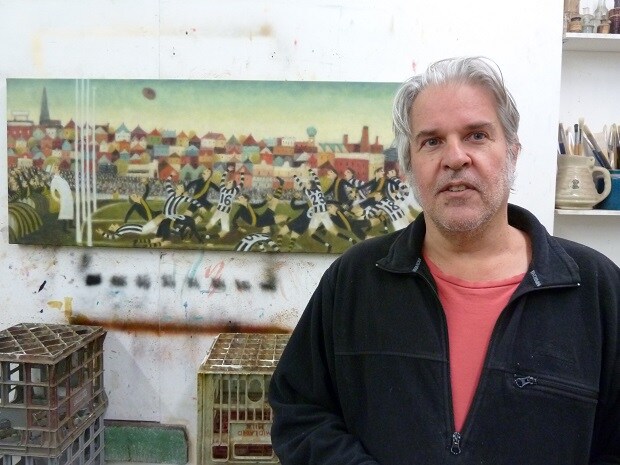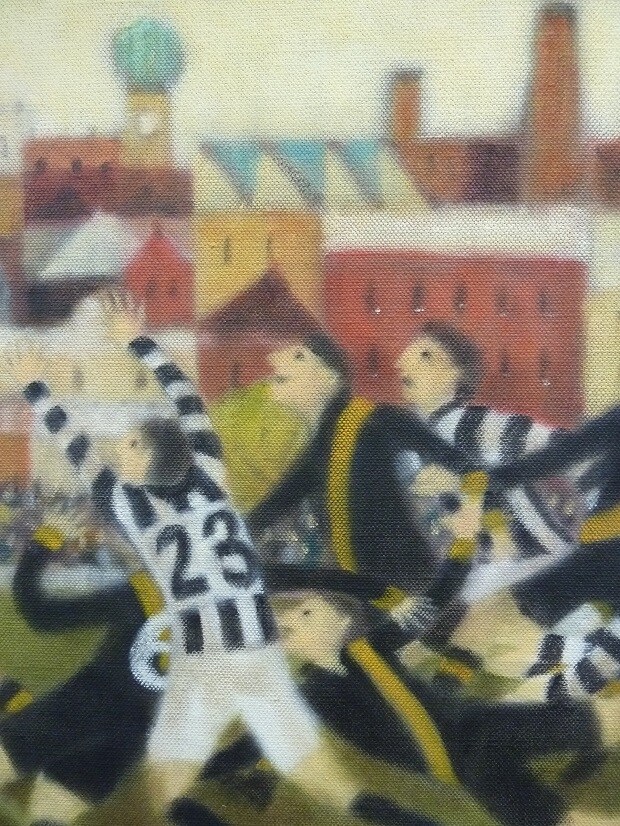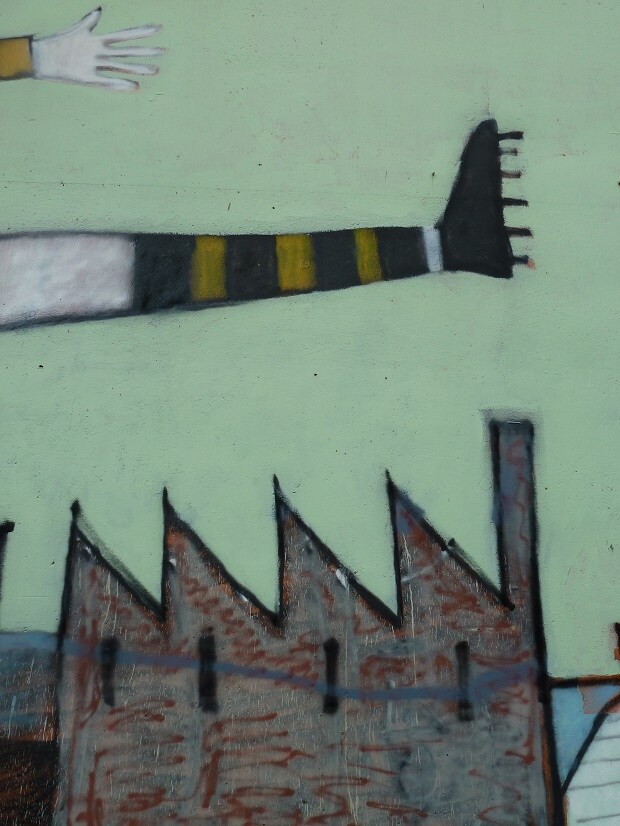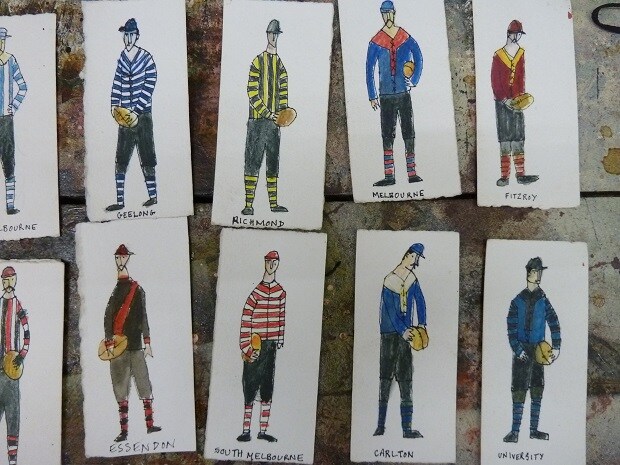Oh we're from Tigerland
Stories of being Richmond
Nick Howson, 54, Richmond
Favourite all-time and current Richmond player: N/A (see below).
Early in the third quarter it seemed a bad idea. The night was cold and the Pies hot. I’d arranged to meet an artist on Friday morning, a man who a few years back painted a large mural by Richmond Station, of a footballer in our colours floating over the chimney stacks and saw-tooth factory roofs, over all the working-class history of old Struggletown.
He lives in Richmond, this artist, above a Swan Street shopfront, on its rise near Church Street. His art is of its place, depicting the shapes, colours, textures of Richmond, the suburb. His public mural, called ‘Tiger Legend’, is inspired by the lore of Jack Dyer.
Only problem is, this painter, he barracks for Collingwood.
He’s one of them. And early in the third quarter last Thursday night, when they had most of the ball and a handy lead and Treloar and Grundy were everywhere, meeting up with a Magpie looked a foolhardy proposition. But then up stepped Jack and the rest, as they say, is history.

Tribal ritual: a game, a place, the church on the hill, a goal umpire in white arching his back - Nick in front of one of his latest works.
Nick Howson, an Englishman, from the West Midlands, migrated to Melbourne in late 1969, a Richmond premiership year, knowing nothing of the local game. Six-years-old and starting primary school in Doncaster East, an old Fitzroy recruiting zone, he picked a team for reasons of pity, as is an artist’s way.
“I felt sorry for them,” he says, of the aftermath of the epic 1970 Grand Final when the vanquished gave-up a 44-point half-time lead to Carlton.
Collingwood, anyway, was a popular club at his Catholic school, so there was safety in the mob. He recalls an occasion when the club’s star full-forward, Peter McKenna, paid a visit. “All the children were pushed to the back of the room and all the parents got to the front,” he says. “They idolised him.”
About twenty years ago, Nick moved to Richmond with his wife, after art school and years of living in St Kilda and Elsternwick, and this new whereabouts triggered his creative inquiry into football and Richmond, the place. He felt its tribal heartbeat, the jungle drums of Tigerland, a cultural yearning too visceral to ignore.
“It wasn’t until I came here I realised how prominent football was in Richmond, I guess because of the proximity to the MCG,” he says. “On the side of the river you’d never really know when a game is on, the football wasn’t part of the local identity.”
Living on Swan Street, on a main artery to the ground, Nick says it’s impossible not to fall in tune with the pulse and rhythms of the game. “Especially when Richmond play and they win,” he adds. “The fans spill onto the street and into the pubs, with car horns beeping as they go home.”
Richmond’s built environment, its resplendent Federation-era redbrick factory walls such a hallmark of the city’s south ward, were another of his muses. “It was the colours that got me,” he explains, from his studio, behind a shopfront.
“The beautiful reds in the bricks, and the oranges, the dirty bricks, they influenced an exhibition I held after moving here that I called Struggletown. The story of Richmond fascinates me.”

Contested possession: detail from one of Nick's commissioned works showing an olden-day Shaun Grigg (No 6) putting defensive pressure on their Lachie Keefe.
It’s a richly-layered tale, of a former industrial neighbourhood, stepped-down to the river, to lowlands perfumed long ago with burning malt, vinegars, chutneys, sauces, preserves, condemned by geography, by factory trades, by a history of being without. Pubs and privations were never far away in old Richmond, a place where the Great Depression came early and finished later, and left a psychological scar deeper than almost anywhere else. In the 1933 Census, at a mid-point of the downturn, 29.9 per cent of Richmond’s male workforce was unemployed and 13.5 per cent of female workers were without a job – rates exceeded in the city only by Melbourne, Collingwood and Fitzroy.
And at this toughest time, the suburb put together its toughest teams, bookending the census with premierships, with the 1934 flag over the ‘Bloods’ from South Melbourne featuring a young and fearless footballer known as Jack Dyer. The following season, a newspaperman nicknamed him ‘Captain Blood’.
It’s a landscape etched with storytelling, with the distant sounds of the MCG – a siren, the crowd’s roar rising and falling like a crashing wave – all rich pickings for an artist.
“Collingwood is not as beautiful as Richmond,” says Nick. “Richmond has the fantastic church sitting on top of the hill and the Dimmey’s tower with its beautiful pepper blue and yellow, two landmarks that really capture place. My football paintings are always taken from Punt Road Oval, so I always put a Richmond footballer in them and it’s always looking up to the church.”

Cultural landmarks: the Dimmey's clocktower dome, a flying red Sherrin.
But for Richmond fans and residents, and all who pass through, Nick Howson’s great contribution to our cultural capital is a large public mural he took it upon himself to paint on a wall beside Richmond Station. It was an act of derring-do, audacious art, of one man making a difference in the crowd.
“One day I grabbed my brother who had scaffolding, and we put on yellow jackets and just did it on a Saturday,” he explains. “As soon as I drew the Richmond sock with the black and yellow, we just had people driving past beeping horns. That was great fun.”

Tigerland: A leg, a boot, a saw-tooth factory roof.
The mural, based loosely on Jack Dyer and footballers of yesteryear with their long-sleeved collared jumpers and long boot studs, and their short back and sides haircuts, was unauthorised. After about six fruitless months of seeking permission through Yarra Council and the railways, Nick just went ahead with his grand plan.
“I’d been eyeing off that wall and thinking I’d love to paint something on that, and it just had to be a Richmond footballer.”
Block colours in yellow and black, factory roof lines, the Dimmey’s clock tower – his is a creativity that enriches a community, redolent with history of a time and place, of local belonging.
“Being in Richmond allowed me to be a kid again, and do football drawings and paintings. It freed me up. On the other side of the river the football is not important, but here it is. You just want to be part of Richmond.”

Old traditions: where is West Coast?
And now to Saturday afternoon, to the tradition of a 2.10pm home game at the MCG, with its golden autumn light lowering in the third quarter, the lengthening shadows, and all the pride and history of Richmond up against a modern footballing confection. Our hard boys of old Struggletown, of a place, against their manufactured side representing, well, the entire western third of Australia.
If we win, WHEN we win, listen to the roar, see the colours, hear the song. That’s Tigerland. It’s a passion steeped in history. You cannot concoct tradition like it. It’s guttural and it’s all-consuming and it’s a self-expression of all it is to be Richmond.
Go Tiges!
If you would like to nominate a Richmond fan who has a story to tell about their barracking please email Dugald Jellie with details: dugaldjellie@gmail.com
For a few words on the sweet train trip home last Thursday night, see www.tigertigerburningbright.com.au



